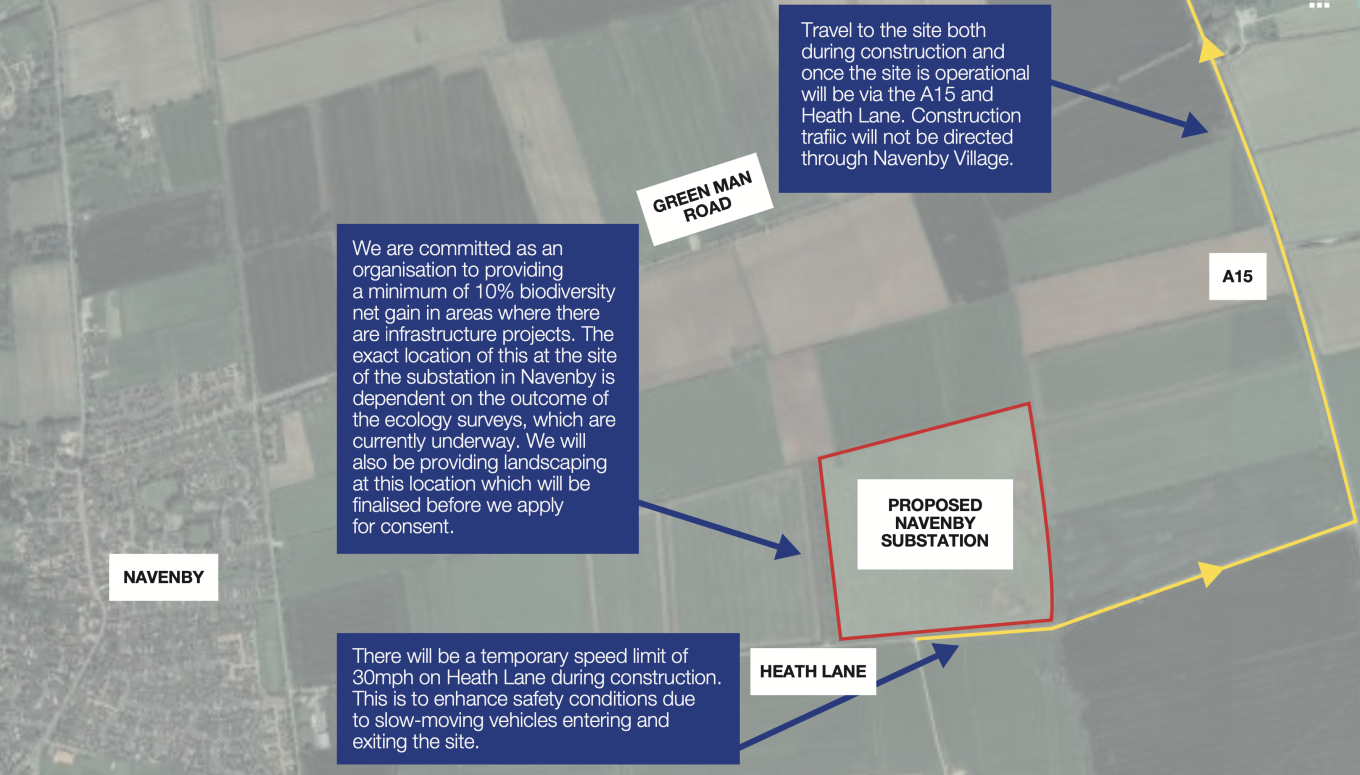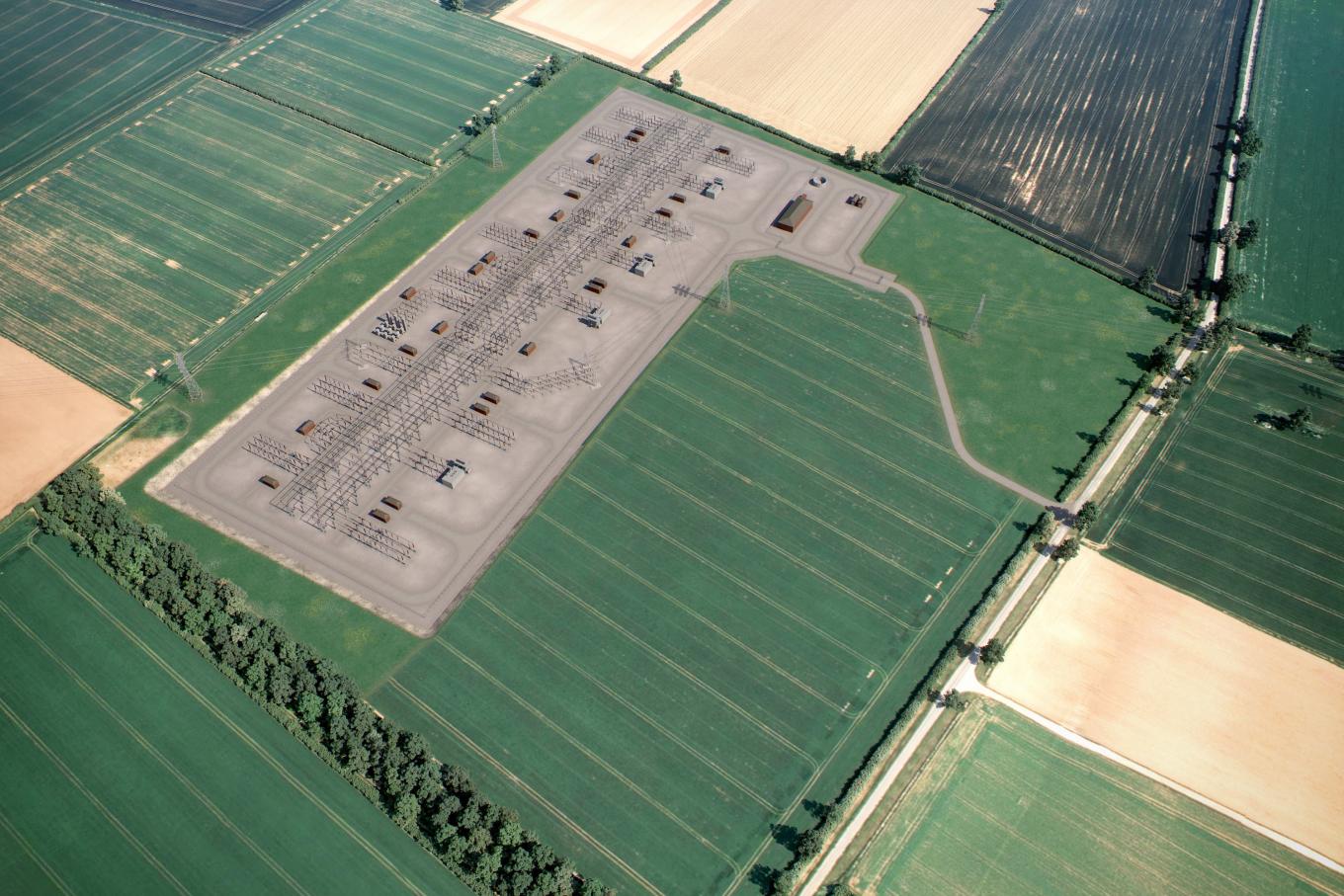Following responses to our Environmental Impact Assessment (EIA) scoping request and advise from Heritage Lincolnshire, we will be carrying out archaeological trial trenching work at the proposed site for Navenby Substation to support our planning application.
Work is expected to take place between Monday 17 November until early 2026. These works will be carried out between 8am and 5pm, Monday to Thursday and 8am to 1pm on Fridays. In exceptional circumstances weekend working may be required, but it is not expected to be necessary.
Once the works are complete, all areas will be reinstated, and the results will be reviewed. Noise levels resulting from the works will be low and any disruption will be minimal.
National Grid Electricity Transmission is preparing to submit a planning application for a substation approximately 1.4km from the village of Navenby.
What we need to do
The way we generate electricity has changed and is continuing to change. This project is being developed alongside The Great Grid Upgrade to connect more homes, businesses and public services to sources of home-grown renewable energy which can lower our electricity bills and make our country more energy secure.
We’re responsible for making sure electricity is transported safely and efficiently from where it is produced to where it is needed and as a regulated business, we have a legal obligation to connect customers to our network when a connection request is made.
Based on current demand around Navenby, it’s not possible to connect everything proposed in the area to existing regional substations such as Bicker Fen. To connect new developments to our network, we’ve identified that a new 400 kilovolt (kV) substation is needed.
Our proposals
The proposed substation would be located to the north of Heath Lane and set back from the road, covering approximately 32 acres.

It will be an ‘open air’ substation with a maximum height of 15 metres. While four new pylons will need to be constructed as part of the plans, the project will see two pylons near to the site dismantled.

We've identified this site as the most suitable option through a formal substation siting study, where five possible sites were shortlisted.
From these five evaluated sites in the local area, a rigorous optioneering process was carried out, taking into consideration the impact on the local community, proximity to the existing overhead line to reduce the need for new pylons and overhead lines, environmental factors, land availability and much more.
Consultation
Our consultation for Navenby substation closed on 17 October 2024. Thank you to everyone who provided feedback and attended either our online or in-person event.
Copies of the banners and other materials issued throughout our consultation can be found in the document section below.
Next steps
As we review the feedback submitted and finalise our planning application, you may notice members of our team including contractors acting on our behalf around our proposed location for the substation. We expect to complete all the necessary surveys to support our application by late 2025, and are therefore aiming to submit our planning application to North Kesteven District Council in early 2026.
We have been granted consent by the relevant landowners for this activity where required, and National Grid will continue to work to ensure all necessary permissions are obtained. Together with our contractors, we aim to complete the work with the least disruption to local residents and visitors to the area as possible.
Please note that this activity does not represent the start of construction activity on the project, our anticipated timeline for the project, if approved is as below:

Get in touch
If you have any questions about our proposals, contact our community relations team on 0800 3196 183 or email us by clicking the button below.
You can also write to our team using our freepost address:
Navenby Substation, Freepost GIVEYOURVIEW (no stamp or further address required).
Documents
You can view all of our published consultation documents and materials below.
| Consultation newsletter |
| Printable feedback form |
| Consultation banners |
| FAQ booklet |
It has taken slightly longer than expected to ensure our site investigations are as detailed as possible. We have delayed submission of the planning application until early 2026 so that these findings can be fully incorporated into the substation proposals.
To minimise disruption to residents, no construction traffic will be directed through Navenby village. Travel to the site, both during construction and once the site is operational, will be via the A15 and Heath Lane. To support this, we will also provide clear signage around the location during construction to make sure our vehicles use the agreed traffic measures.
We are also proposing a temporary speed limit of 30mph along Heath Lane, during construction, to enhance safety as a result of slow-moving vehicles entering and leaving the site.
The Great Grid Upgrade is the largest overhaul of the grid in generations and will future proof the Grid for years to come, facilitating the transition to a clean and affordable energy future. It will enable us to carry more clean, secure energy from where it is generated to where it is needed, boosting energy security and helping the nation become more self-sufficient.
Projects which are part of The Great Grid Upgrade aim to enhance the grid's capacity to handle increased renewable energy, ensuring a reliable and sustainable power supply.
Find out more about The Great Grid Upgrade.
National Grid sits at the heart of Britain’s energy system, connecting millions of people and businesses to the energy they use every day. We bring energy to life – in the heat, light and power we bring to our customer’s homes and businesses; in the way that we support our communities and help them to grow; and in the way we show up in the world. It’s our vision to be at the heart of a clean, fair and affordable energy future.
National Grid is a group of companies, and one of those companies, National Grid Electricity Transmission (NGET), owns, builds and maintains the high voltage network in England and Wales. It is NGET who is developing plans for the Navenby Substation project.
Within the National Grid Group there are other distinctly separate legal entities, each with their individual responsibilities and roles. More information about National Grid can be found on the ‘about us’ section of National Grid’s website.
NGET owns, builds and maintains the high-voltage electricity transmission network in England and Wales. This network operates primarily at 400,000 volts (400kV) and 275,000 volts (275kV).
National Grid Electricity Transmission is consulting on proposals to build a new substation in the local area, approximately 1.4km from Navenby, Lincolnshire.
There is a shift towards renewable energy sources, meaning there is greater demand on our network to connect new sources of electricity and customers. The proposed substation at Navenby is in response to the increase in connection requests through the National Energy System Operator (NESO) and increased consumption of electricity that will continue to grow. In the Navenby area several developers have requested new power connections from National Grid, including Springwell Solar and Fosse Green and, as a regulated business, we have a legal obligation to meet these requests.
The substation will be set back from the road and cover approximately 32 acres. It will be an ‘open air’ substation, with the equipment installed on site a maximum height of 15 metres. The proposed substation is contained within one site and will facilitate the seven customers that currently need to connect to Navenby Substation.
Access and transport will be considered as part of our planning application. This will include an estimation of vehicle numbers and types, and will consider the potential impact of this on the existing traffic numbers. We will put in place a Traffic Management Plan to help reduce disruption.
In the Navenby area several developers have requested new power connections from National Grid, and as a regulated business, we have a legal obligation to meet these requests. Due to the number of requests in the local area, a new substation is required to connect these developers.
There is the potential of some noise during construction, but our contractors will regularly monitor noise to ensure it stays within the levels permitted under local environmental health requirements.
We don’t anticipate any significant noise when the proposed new substation is operational. Typically, substations generate a low frequency ‘hum’, similar to the sound from overhead lines when operational. However, to support our planning application, we will be carrying out acoustic surveys to assess background and operational noise, which will also inform whether we need to consider any mitigation measures, such as landscaping and acoustic fencing, to minimise any potential impacts on surrounding residential areas.
We have agreed with the Local Authority that the noise assessment process will be defined by the British Standard BS4142 ‘Method for rating and assessing industrial and commercial sound’, which considers the potential for noise impact at the quietest times of the day or night. BS4142 also applies corrections to noises that may be considered out of character with the local environment.
Following this process will enable us to define any appropriate noise mitigation measures. We would aim to ensure that any new noise does not exceed the representative nighttime background noise level at surrounding residences, although this may not always be possible in all cases. As a result, we anticipate that any change in noise emissions due to the operation of the new substations will be fully controlled and minimised.
We’ll ensure that any light pollution is kept to minimum during construction and when the substations are operational. Substations aren’t generally lit or permanently illuminated, other than sensor-activated security lighting for nighttime access.
We are currently undertaking a programme of archaeological surveys, and once we are able to share further information from these surveys, this section will be updated.
An Environmental Impact Assessment (EIA) is being carried out to assess the likelihood of the planned works giving rise to significant effects on the environment. The EIA is informed by assessments on areas including ecology, species, habitats, flood risk, transport, heritage, landscape and views, and ground conditions. Once we are able to share further information from these surveys, this section will be updated.